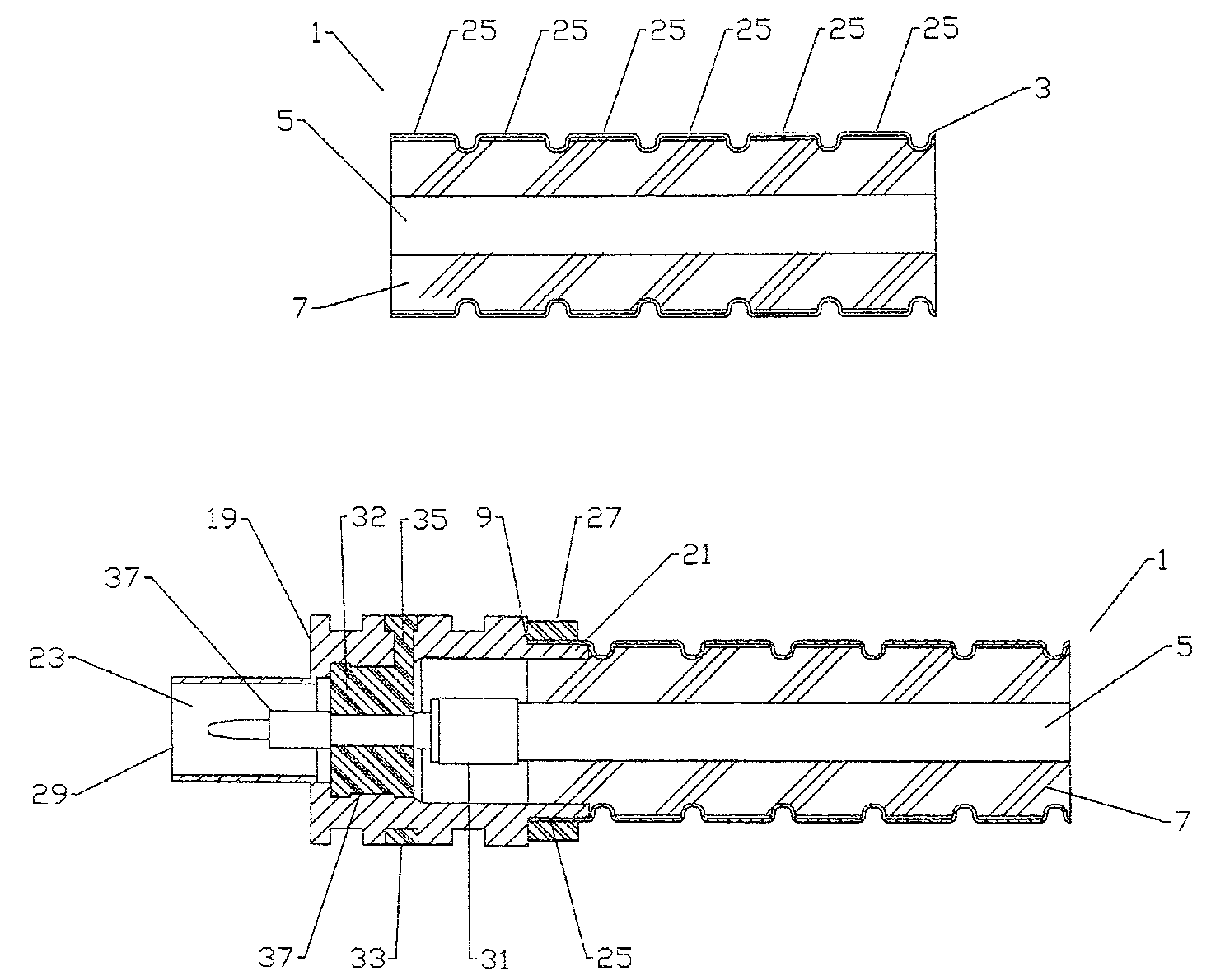Connector and coaxial cable with outer conductor cylindrical section axial compression connection
a technology of connecting rods and coaxial cables, which is applied in the manufacture of contact members, coupling device details, coupling device connections, etc., can solve the problems of limiting the use low material cost of smooth wall cables, and relatively inflexibl
- Summary
- Abstract
- Description
- Claims
- Application Information
AI Technical Summary
Benefits of technology
Problems solved by technology
Method used
Image
Examples
first embodiment
[0020]the invention is shown in FIGS. 1 and 2. A typical annular corrugated coaxial transmission line cable suitable for use with the invention is LDF4 manufactured by the assignee of the invention, Andrew Corporation of Orland Park, Ill. The cable 1 has an outer conductor 3 with annular corrugations and an inner conductor 5 surrounded by dielectric material 7. Prepared for axial compression, any outer protective sheath of the coaxial cable 1 is stripped back and the cable end 9 inserted through a sleeve 11. The sleeve 11 may be configured with a sleeve bore 12 having a wider sleeve cable end 13 diameter that transitions to a sleeve connector end 15 diameter which extends to the sleeve connector end 15. The sleeve cable end 13 diameter may be, for example, adapted to accept insertion of the cable 1 with the outer protective sheath in place. The sleeve connector end 15 diameter is only slightly larger than the diameter of the outer conductor 3, allowing insertion of the outer conduct...
second embodiment
[0024]In the invention, axial compression is similarly applied but flaring and drawing of the outer conductor 3 into a cylindrical section 25 is avoided by forming the coaxial cable 3 with extended cylindrical section(s) 25 at each corrugation peak.
[0025]As shown by the cable 1 used with the first embodiment (FIGS. 1 and 2), the sinusoidal form of annular corrugations common in prior coaxial cables have a roughly equal dimension at the peak of the corrugations compared to the bottom corrugation dimension. As shown in FIG. 3, the cylindrical section(s) 25 of the novel cable 1 according to the invention have a length of at least four times that of the corresponding corrugation bottom, depending on the overall cable dimensions. Preferably, the cylindrical section is formed with a ten to one peak corrugation width to bottom corrugation width or at least a three millimeter corrugation peak cylindrical section 25.
[0026]As the length of each cylindrical section 25 is extended, the cable 1 ...
PUM
| Property | Measurement | Unit |
|---|---|---|
| length | aaaaa | aaaaa |
| width | aaaaa | aaaaa |
| compression force | aaaaa | aaaaa |
Abstract
Description
Claims
Application Information
 Login to View More
Login to View More - R&D
- Intellectual Property
- Life Sciences
- Materials
- Tech Scout
- Unparalleled Data Quality
- Higher Quality Content
- 60% Fewer Hallucinations
Browse by: Latest US Patents, China's latest patents, Technical Efficacy Thesaurus, Application Domain, Technology Topic, Popular Technical Reports.
© 2025 PatSnap. All rights reserved.Legal|Privacy policy|Modern Slavery Act Transparency Statement|Sitemap|About US| Contact US: help@patsnap.com



